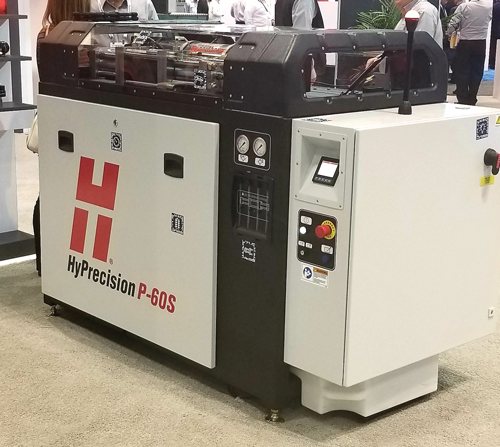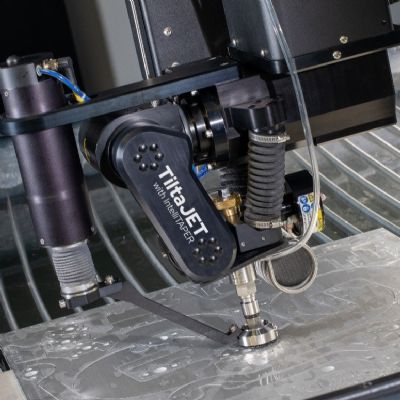In one example highlighting the ramifications of failure in a high-production environment, an automotive Tier One recently experienced a 25-minute pump failure. The seemingly minimal downtime translated to 41 worker-hours lost, ultimately made up via unscheduled weekend work.
“That’s why, as suppliers, our fabrication customers always ask how long the pump seals will last…the impact on production can be enormous,” Dumas says.
Methods for Monitoring Pumps and Seals
Given the importance of pump-seal operation, how do fabricators monitor the life of these components?Typically, according to Kobzik and Dumas, waterjet cutting machine operators and/or maintenance personnel monitor the rate of drips coming from the seals.
“They might look at the pump every once in a while, and figure that if a seal has one drip per stroke, it’s time to change the seals,” Kobzik explains. “Or, a drop in water pressure might signal the need for replacement.”But the pressure may not drop for long because a pump with a built-in mechanism would sense the drop in pressure, attributing it to the system cycling too quickly.
“Sensing the ‘overcycle’ condition, the pump would shut down,” says Dumas, “resulting in unplanned downtime.”
To avoid such fates, fabricators often decide that reaching a certain drip rate should trigger seal replacement, which allows operations to actually plan downtime and make arrangements to work around it.But, Kobzik and Dumas caution, proactive seal replacement in such circumstances can be costly.“Even when fabricators change pump seals when reaching a one drip/stroke rate, they miss out on usable seal life, which could be as much as 40 percent,” Kobzik explains.
Be Proactive in Maintaining
Fabricators do have tools to properly maintain waterjet cutting machines and various system components. Equipment manufacturers provide specific maintenance and troubleshooting tips and advice. Also available, software that monitors machine performance and various maintenance factors and schedules, and alerts users to issues. But, as Kobzik detailed to MetalForming at FABTECH 2019, predicting pump and pump-seal issues can be tricky and costly. Challenges abound in maintaining waterjet machines, and in incorporating effective preventive maintenance to ensure continued reliable performance and minimize unplanned downtime.
To provide for predictive maintenance, Kobzik provided a look at Hypertherm’s HyPrecision Predictive series of predictive-maintenance waterjet pumps, which the company displayed at the Chicago show. The new generation of pumps feature Hypertherm’s Advanced Intensifier technology, which includes sophisticated electronics providing smooth shifting for optimal cut quality and pump performance, he says. To ease servicing, the intensifier’s new design reportedly eases high-pressure end removal for seal maintenance. And, the check valve utilizes a screwless, low-pressure poppet design that enables users to quickly evaluate key contact surfaces to speed routine servicing.
Other maintenance-helpful standard features include closed-loop proportional pressure control that adjusts for pressure and temperature, oil viscosity, and hydraulic-system wear parts.
And, the pumps include color-coded junction boxes, electrical-cable harnesses, quick-disconnect fittings, and easy-access bleed-down valves. The pump’s clear window cover lets the operator sees the intensifier and attenuator. Also, Hypertherm’s Seal Maintenance technology improves safety by keeping the top deck and shop floor free of oil and water, according to Hypertherm officials.
“The Predictive series provides a yellow-light signal to let users know that seals will fail in, say, the next 30 hours or so and then provides a final red-light signal of less than 1 hour before the system will go down,” Kobzik explains, noting that such signals also can be sent directly to a waterjet’s CNC. “That provides time to plan for maintenance, but prevents early replacement of the seals.”
For users that require 24/7 operation of waterjet cutting machines, options abound.
“For example,” says Dumas, “one of our fabricator customers is installing three of these new pumps tied together, so that when the yellow light comes on, one of the other pumps automatically starts and achieves needed pressure, and the leaking pump will shut down—no lost production time.”
Development of the new pump arose from fabricator feedback, where waterjet cutting machine users felt challenged by serviceability and preventive maintenance, according to Kobzik and Dumas.
“Whether they be automotive Tier Ones or job shops, the cost of down time in money, hours and late delivery can seriously impact fabricators,” sums up Dumas. “Anything that reduces unplanned downtime in waterjet cutting is a win.” MF
See also: Hypertherm, Inc.
Technologies: Cutting









